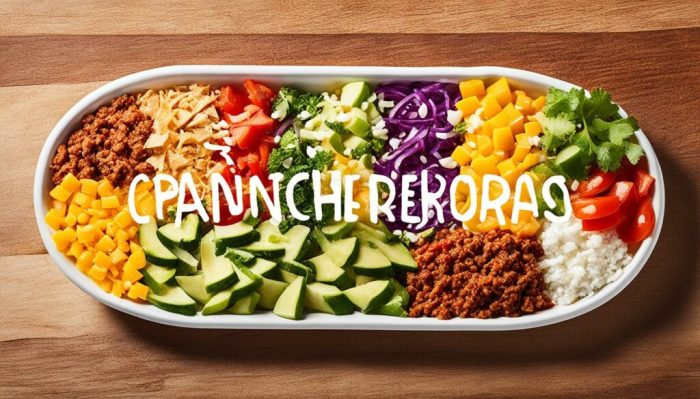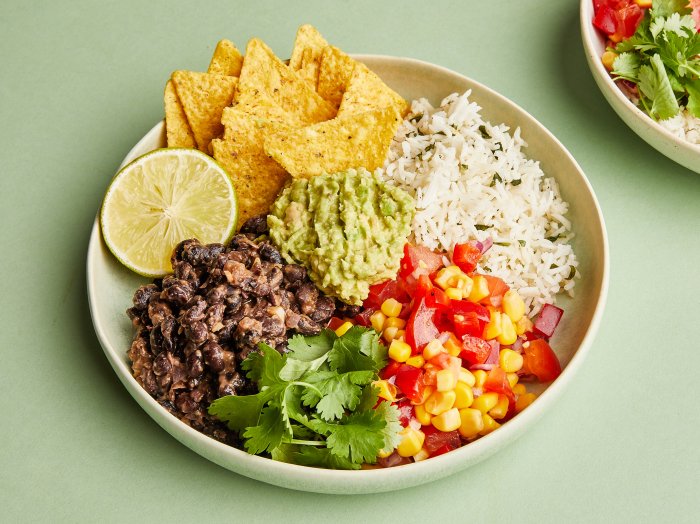Calorie and Macronutrient Breakdown

Burrito bowl nutrition facts – Understanding the nutritional content of your burrito bowl is key to enjoying it as part of a balanced diet. This section will break down the typical calorie and macronutrient profile of a standard-sized bowl, and explore how ingredient choices significantly impact these values. Remember, these are estimates, and the actual nutritional content will vary depending on specific ingredients and portion sizes.
A standard burrito bowl, approximately 1.5 cups, typically contains a mix of rice, beans, protein, vegetables, and salsa. Let’s examine a sample nutritional breakdown:
Sample Nutritional Information
| Nutrient | Amount |
|---|---|
| Calories | 750-850 |
| Protein | 30-40g |
| Carbohydrates | 90-110g |
| Fat | 25-35g |
Note that these values are approximate and can vary considerably depending on the specific ingredients used and their quantities. For example, choosing brown rice instead of white rice will increase the fiber content and slightly alter the carbohydrate breakdown. Adding extra cheese will significantly increase the fat and calorie count. Selecting a lean protein source, such as grilled chicken breast, will result in a lower fat content compared to choosing carnitas (slow-cooked pork).
Portion Size Impact
Portion control is crucial in managing calorie and macronutrient intake. A smaller burrito bowl (approximately 1 cup) might contain around 500-600 calories, while a larger bowl (2 cups) could easily exceed 1000 calories. The proportional increase in macronutrients mirrors the calorie increase. Consider a scenario where a person regularly consumes a large, high-calorie burrito bowl. Over time, this consistent overconsumption could contribute to weight gain if not balanced with other dietary choices and sufficient physical activity.
Conversely, smaller portions contribute to better calorie management.
Ingredient Choice Impact
The selection of ingredients dramatically alters the final nutritional profile. For instance, swapping white rice (high glycemic index) for brown rice (lower glycemic index) improves the bowl’s nutritional value by adding fiber and slowing down glucose absorption. Choosing black beans instead of refried beans reduces the fat content. Opting for grilled chicken or fish as a protein source provides lean protein and lowers the overall fat compared to ground beef or carnitas.
Similarly, reducing the amount of cheese or sour cream significantly lowers the fat and calorie count. A visually appealing example would be comparing a burrito bowl with a generous helping of cheese and sour cream versus one with a modest amount – the difference in appearance would be noticeable, reflecting the difference in the calorie and macronutrient content.
Micronutrient Content and Health Benefits
Burrito bowls, when constructed thoughtfully, offer a powerhouse of micronutrients crucial for optimal health. Beyond the satisfying macronutrient profile, the vibrant array of ingredients contributes significantly to your daily vitamin and mineral intake, boosting your overall well-being. Understanding the specific micronutrients and their benefits allows you to craft a bowl that’s not only delicious but also nutritionally superior.A well-balanced burrito bowl can easily incorporate a significant portion of your recommended daily allowance for several essential vitamins and minerals.
Okay, so you’re all about that burrito bowl life, right? Tracking those calories and macros is key, especially if you’re trying to stay on top of your fitness game. But let’s be real, sometimes you crave something totally different, like a Bruegger’s bagel – check out their nutrition facts here: bruegger’s bagels nutrition facts. Then, it’s back to the burrito bowl – gotta balance that deliciousness with those healthy choices!
The combination of lean protein, whole grains, and an abundance of colorful vegetables creates a synergistic effect, maximizing nutrient absorption and bioavailability. This synergistic approach to nutrition is key to reaping the full health benefits of this versatile meal.
Vitamin and Mineral Contributions from Common Ingredients
The nutritional profile of a burrito bowl is highly dependent on ingredient selection. However, common components consistently contribute vital micronutrients. For example, brown rice provides essential B vitamins like thiamine (B1), riboflavin (B2), and niacin (B3), all vital for energy metabolism. Black beans are an excellent source of folate (B9), crucial for cell growth and development, and iron, essential for oxygen transport throughout the body.
Adding bell peppers boosts vitamin C, a potent antioxidant, and avocados contribute vitamin K, important for blood clotting and bone health.
Health Benefits of Diverse Vegetable and Legume Inclusion
The inclusion of a variety of vegetables and legumes is paramount to maximizing the health benefits of a burrito bowl. Different colored vegetables often contain different phytonutrients. For example, red bell peppers are rich in lycopene, a powerful antioxidant linked to reduced cancer risk, while dark leafy greens like spinach provide lutein and zeaxanthin, beneficial for eye health.
Including various legumes, such as black beans, kidney beans, or chickpeas, adds dietary fiber, promoting digestive health and contributing to satiety, helping with weight management. The fiber content also aids in regulating blood sugar levels, reducing the risk of type 2 diabetes.
Example of a Micronutrient-Rich Burrito Bowl
Consider a bowl featuring brown rice, black beans, grilled chicken breast, a mix of red and green bell peppers, spinach, avocado, and a light vinaigrette dressing. This combination provides a substantial amount of vitamins A, C, and K, along with various B vitamins, iron, and fiber. The protein from the chicken supports muscle growth and repair, while the healthy fats from the avocado promote satiety and contribute to nutrient absorption.
This balanced approach ensures a meal that is both satisfying and nutritionally complete, significantly contributing to the recommended daily intake of several key micronutrients.
Dietary Considerations and Modifications

Burrito bowls offer incredible versatility, easily adapting to a wide range of dietary needs and preferences. By making mindful ingredient swaps and portion adjustments, you can create a delicious and nutritious bowl that aligns perfectly with your health goals, whether you’re a vegetarian, vegan, gluten-free, or following a low-carb lifestyle. This section will guide you through the process of customizing your burrito bowl to meet your specific dietary requirements.
Understanding the nutritional profile of your chosen ingredients is key to successful modification. This allows for precise control over macronutrients, micronutrients, and the overall caloric density of your meal. Remember, even small changes can significantly impact your overall dietary intake.
Vegetarian Burrito Bowl Modifications, Burrito bowl nutrition facts
Creating a vegetarian burrito bowl involves simply omitting the meat and focusing on plant-based protein sources. Excellent options include black beans, pinto beans, lentils, chickpeas, or seasoned tofu. Adding a variety of colorful vegetables will boost the nutritional value and appeal of your bowl. Consider incorporating roasted sweet potatoes for sweetness and vitamin A, bell peppers for vitamin C, and spinach for iron.
A flavorful vegetarian chili can also serve as a hearty and protein-rich base.
Vegan Burrito Bowl Modifications
To make your burrito bowl vegan, ensure all ingredients are plant-based. This means avoiding cheese, sour cream, and any other animal-derived products. Replace cheese with a vegan alternative, such as nutritional yeast for a cheesy flavor or a cashew-based cream for a creamy texture. Vegan sour cream options are readily available in most grocery stores. Remember to check labels to ensure products are free from animal products and by-products.
Gluten-Free Burrito Bowl Modifications
For individuals following a gluten-free diet, focus on naturally gluten-free ingredients. Rice, quinoa, and corn are excellent gluten-free bases for your bowl. Be cautious of potential cross-contamination; ensure that your chosen ingredients, including sauces and seasonings, are certified gluten-free. Many commercially available spices and seasonings are gluten-free, but always double-check labels to be certain.
Low-Carb Burrito Bowl Modifications
To create a low-carb burrito bowl, minimize the amount of starchy ingredients like rice and beans. Opt for a larger portion of non-starchy vegetables such as cauliflower rice, broccoli, or zucchini noodles. Increase your protein intake with grilled chicken or fish, or use a generous amount of plant-based protein such as lentils or tofu. Be mindful of hidden carbohydrates in sauces and dressings, opting for low-carb alternatives.
Sodium, Sugar, and Fat Control in Burrito Bowls
Controlling sodium, sugar, and fat content is achievable through careful ingredient selection and portion control. Reduce sodium by using fresh herbs and spices instead of relying heavily on salty sauces and pre-packaged seasonings. Limit added sugars by avoiding sugary dressings and opting for naturally sweet options like fresh fruit. To manage fat content, choose lean protein sources and use healthy fats such as avocado or a small amount of olive oil in moderation.
Always check nutrition labels for sodium, sugar, and fat content per serving.
FAQ Overview: Burrito Bowl Nutrition Facts
Can I make a burrito bowl vegan?
Absolutely! Swap the meat for tofu, beans, or lentils, and ensure your other ingredients (like cheese and sour cream) are vegan-friendly.
Is a burrito bowl a good option for weight loss?
It can be! Portion control is key. Opt for lean protein, plenty of veggies, and brown rice for added fiber to keep you feeling full and satisfied.
How can I reduce the sodium in my burrito bowl?
Choose low-sodium ingredients, limit added salt, and rinse canned beans to remove excess sodium.
Are burrito bowls gluten-free?
Not always. Check that your rice, beans, and any sauces are certified gluten-free. Many contain gluten unless specifically labeled as gluten-free.
